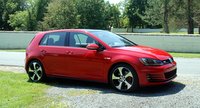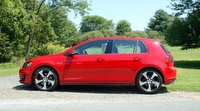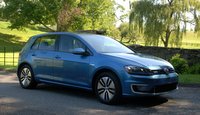Now Available Three Spiced-Up Versions–Gas, Diesel or Electric
If variety is the spice of life, anyone with a sensitivity for Sriracha sauce has better step away from the new 2015 Volkswagen Golf. VW is launching the seventh generation of its worldwide best-seller this year and it’s stepping up its game. The Golf has completely redone both gas and diesel engines as well as added a brand-new electric motor in the soon-to-be-on-the-market (finally) e-Golf.
The styling of the Mk 7 Golf is evolutionary, but those who follow the Euro hatchback will notice the changes–it’s bigger, lighter and more fuel-efficient. Golf aficionados might pick up on the two plus longer, ½-inch wider and one-inch lower stance, but the rest of us will just appreciate the lower coefficient of drag’s positive impact on its fuel economy.

The variety does mean the Golf buyer will need to make a choice and it is beyond just the different powertrains. However, let’s start with that foundational element, which will define the basic character of your Golf.
New And Different/e-Golf
The e-Golf represents a new foray for Volkswagen–a production pure battery electric car. The company has shown a variety of concepts, including the smaller e-Up!, and the ultra-efficient science project, the XL1. VW decided the Up! is too small for the U.S. market and the XL1 is a very limited production plug-in diesel-electric hybrid.
The e-Golf represents what VW considers the sweet spot of the EV market–a compact yet highly functional five-door hatchback that they’re already producing in large volume (so the basic tooling costs are covered). Clean Fleet Report has driven two previous iterations of the e-Golf, both of which appeared to be ready to enter production. This latest (still pre-production) version continued VW’s tradition of building electric cars that not only deliver zero emissions but some of the expected driving fun that defines the Golf. With real five-passenger seating and functional storage space behind the hatch, Golf ups the ante in the growing EV market.
The e-golf is set to arrive late in 2014 and will deliver 70-90 miles of real-world range (100+ in Eco+ mode) from its 24.2 kWh lithium-ion battery and electric motor with 115 hp/199 pound-feet of torque (which compares favorably with the gas and diesel models). VW claims the e-golf will deliver more interior volume and torque than either the Ford Focus Electric or Nissan Leaf. Its retail price of $36,265 (including destination charge) will place it between the segment sales leading Leaf and the just-introduced German rival BMW i3.
The Driver Gets to Choose
One unique feature of the e-Golf is driver-selected driving profiles and regenerative braking, with three settings for each. The driving profiles range from Normal through Eco to Eco+ with the Eco modes moderating the electric motor output, top speed, A/C output and throttle response to maximize efficiency. The three regen modes range from normal to “B,” which puts on the brake lights when engaged as it actively slows down the car whenever the throttle is lifted. Aggressive doesn’t do justice to describe the intensity of the top regen level, but it could get old if engaged during normal city driving.

The e-Golf will distinguish itself from its sister ICE Golfs by using LED headlights and low rolling-resistance tires on unique 16-inch aluminum alloy wheels. It also employs a lower coefficient of drag (.028 due to tricks such as reducing the volume of cooling air via a radiator shutter by using a partially enclosed radiator grille; new underbody paneling; a rear spoiler and C-pillar air vanes to better manage airflow at the tail of the car; and cleaning up the airflow around the wheels, largely by ensuring they are flush with the wheel arches).
Like many of its competitors, the e-Golf will only be available in select states (those offering California emissions credits). It will come in an up-level SEL trim, which include a good selection of features such as a touch-screen navigation system, VW’s Car-Net connected services, heated front seats, Bluetooth and a rearview camera.
Diesel Updated
Diesel engines have been a part of the VW repertoire for decades. At one point they had the dubious distinction of being known as the “diesel Rabbit” car company. That was then; this is now. The diesel engines are quieter and cleaner (the 2015 turbocharged 2.0-liter engine has 40 percent lower emissions than its predecessor, which still met California’s strict emissions standards). What remains constant is the combination of power from its low-end torque, fuel economy from its overall efficiency and the durability that comes from a compression ignition engine designed to endure constant explosions within.
For the first time, VW has redesigned its diesel engine to worldwide standards so one engine (in various states of tuning and emissions) will serve markets everywhere. The all-new TDI (for turbo diesel injection) gains in horsepower and fuel economy on its predecessor, albeit in barely noticeable numbers (+10 hp/_1 mpg). The gains flow to VW from the economies of scale derived from a world engine.
Driving the TDI provided no revelations. We tested last year’s engine in the Jetta and came away impressed. What’s not to be impressed when you’ve got all the power you need off-the-line and for passing on the freeway, when it’s accompanied by better-than-EPA fuel economy. For those of us who spend a good portion of our time traversing the Interstate, a TDI is a godsend. The new version just ups the ante.
The Old Standby–Gasoline (With a Boost)
The trick is no sleight-of-hand; in its seventh generation (dating from the Gen I Rabbit in 1974) the Golf boasts that it’s bigger yet lighter and more fuel-efficient. Of course the electric version highlighted earlier is truly groundbreaking.

The diesel is better, but builds incrementally on its past. The gasoline version is somewhere in between, but still not joining the 40 MPG Club.
The gasoline-powered Golf comes in two versions–the basic Golf TSI and the performance-oriented GTI. Life the diesel, its engine received a complete revision. The new turbocharged direct-injected 1.8-liter four-cylinder delivers 6 mpg (20 percent) more on the highway than last year’s 2.5-liter version. Manual transmissions as well as automatics are available, something that is becoming more and more rare.
The more powerful (and very popular) GTI model bumps up the power to 210 hp while losing only a few (3-4 mpg) miles per gallon.
Golf Pricing & Fuel Economy
VW has juggled Golf prices this year, dropping them and setting up a clean stair-step for the different models. Here (including an $820 destination charge) are the entry prices for the different models. With optional trim levels and equipment they can easily move up $8-10,000, a common characteristic for German models.
Golf TSI $18,815 – 2-door, manual transmission
25 mpg city/37 mpg hwy/30 mpg combined
Golf TDI $22,815 – 4-door, manual transmission
30 mpg city/45 mpg hwy/36 mpg combined
Golf GTI $25,215 – 2-door manual transmission
25 mpg city/34 mpg hwy/28 mpg combined
e-Golf $36,265 – EPA fuel economy not yet set
More Models Coming
In addition to the TSI, TDI and e-Folks, VW will later be bringing a wagon (formerly the Jetta Sportwagen, which will now be known as the Golf Sportwagen in TSI and TDI versions), a hot with 290 horsepower and all-wheel drive known as the Golf R and finally a hybrid, no doubt piggybacking on the Jetta hybrid technology already on the market.
The choices mean you, the consumer, have to figure out how you intend to drive your Golf. Short bursts around town suite the e-Golf, longer commutes point you toward the TSI or TDI. The TSI has a significantly lower purchase price and good fuel economy. The TDI costs more at the outset, but will save you money every mile even if the per gallon cost of diesel Is a few cents higher than gas. Both are fun to drive.

If fuel economy is not your main focus, the GTI extracts a maximum amount of fun out of the Golf platform–and doesn’t suffer too much at the pump.
If you need more room, wait for the wagon. If you want the true maximum performance, wait for the the R. The hybrid, may trail the others into the market, should offer TDI-like fuel economy, but at a similar or potentially even higher MSRP.

All the Golf variants deliver similar, sporty performance. Road handling in our test drives showed it to be superior to competitive models in this class and price range. Body lean is minimal and the available manual transmission gives the driver the ability to enhance control of the vehicle. Inaide, VW appears to have upped its game, getting back to higher quality materials that look and feel like they come from a more expensive car. Then there’s that German engineering thing. As an example, an engineer shared with Clean Fleet Report that all VW engines are reported in with specifications on the conservative side rather than at the maximum allowable from testing. It may seem like a minor thing, but we see that as a philosophy the means the company will under-promise and over-deliver with its vehicle’s performance. That’s a trait we’ve experienced in our previous testing and one we welcome.
For 2015 Volkswagen has clearly positioned the Golf to be more competitive across the board by lowering prices, boosting performance (both horsepower and fuel economy) and adding content. It’s part of a strategy to push the VW brand into America’s mainstream. Our estimation after some short but vigorous test drives of the new Golf leads us to quote their new marketing mantra–they do define the compact hatchback segment. It’s up to the competition to come up with something to compete, but until then the Golf is our first choice.
Related stories you might enjoy:
First Drive: VW Tiguan Euro-spec TDI
Road Test: 2014 VW Touareg TDI R-Line
Comparison Road Test: 2013 Jetta TDI vs. Jetta Hybrid

3 thoughts on “First Drive: 2015 Volkswagen Golf”